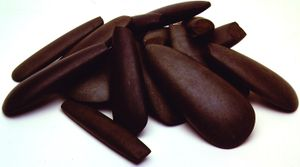The influence of people in Northern Ireland, Northern Ireland
| Mitchell, W I (ed.). 2004. The geology of Northern Ireland-our natural foundation. Geological Survey of Northern Ireland, Belfast. |
R A B Bazley
The influence of people in Northern Ireland

Neolithic people arrived in Ireland, probably from Scotland, before the Flandrian Transgression in the middle Boreal period (Zones S:V and S:VI). They left traces of their existence around the coast of Counties Antrim and Down in the form of kitchen middens and collections of flint tools. In the earliest period of human occupation, Northern Ireland would have been ranked as exceptionally well endowed in the essential natural resources of the day. Rock types such as flint, chert, porcellanite, dolerite/basalt and mudstone were exploited (and in some cases exported) for the manufacture of polished stone axe heads and implements such as flint knives, scrapers and arrowheads. There was an abundant supply of clay suitable for making pottery. Large rock blocks (some glacial erratics) were available for use in dolmens, passage graves and stone circles such as Ballynoe, near Downpatrick. Although there are known occurrences of copper, gold and tin in Northern Ireland their use in manufacture remains unproven. Nor has the prehistoric exploitation of gold in Northern Ireland yet been proven. Occurrences of iron ore include the laterite of the Palaeogene Interbasaltic Formation and bog iron ore but there is no firm evidence for specific exploitation in Iron Age times. Thus with the advent of metal working, Northern Ireland's strength in terms of natural resources declined from its exporting status in Neolithic times.
Porcellanite axe heads from Co. Antrim exceed 10 000 in number and are the most numerous of all the sourced axe lithologies in Britain and Ireland. The porcellanite is a mullite-cordierite-corundum-spinel hornfels that formed by contact metamorphism between degraded basalt lava in the Interbasaltic Formation and olivine dolerite plugs. Occurrences are restricted to two known localities at Tievebulliagh [D 193 268] near Cushendall and Brockley on Rathlin Island [1]. The products of the ensuing axe factories were distributed throughout but not, it seems, beyond Ireland and Britain. The Malone Hoard comprises 19 beautifully finished, probably ceremonial, porcellanite axes, which were found at Danesfort, Belfast (P948048).
The impact of people on the Irish landscape cannot be underestimated. In particular, their use of peat as the primary fuel and, more recently major drainage schemes, has now reduced the area of raised bogs to about 20% of their former extent.
The survival of people in Ireland has, however, largely relied on agricultural practices that are dependent on that thinnest of deposits, the soil. Due to the erosive effects of glaciers soil profiles only started to develop about 10 000BP on the new glacigenic materials and younger deposits. Nevertheless, 308 varieties of soil have been identified in Northern Ireland and reflect the influence of bedrock geology, drift deposits, climate and groundwater chemistry [2]. Artificial and improved natural drainage has expanded the area available for agriculture in particular the reclaimed land, similar to the Dutch polders, at Ballykelly on the south side of Lough Foyle. In modern times, it is the capital city that is extending into Belfast Lough by means of landfill, in the process producing the youngest superficial layer of all.
References
- ↑ Meighan, I G, Jamison, D D, Logue, P J C, Mallory, J P, Simpson, D D A, Rogers, G, Mandal, S, and Cooney, G. 1996. Trace Element and Isotopic Provenancing of North Antrim Porcellanites: Portrush-Tievebulliagh-Brockley (Rathlin Island). Ulster Journal of Archaeology. 56, 25–30.
- ↑ Cruickshank, J G. 1997. Soil and environment: Northern Ireland. The Queen's University of Belfast. Newforge Lane, Belfast. 1–214.